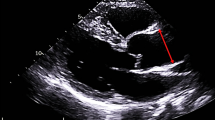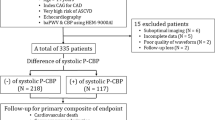Abstract
Although the fractional pulse pressure in the ascending aorta is related to the occurrence of coronary heart disease (CHD) and restenosis after percutaneous transluminal coronary angioplasty, the relative values of diastolic pressure in the ascending aorta at the onset of CHD have not been reported. The purpose of this study was to evaluate whether the relative values of diastolic pressure are associated with the risk of CHD. For this study, we enrolled 406 patients with chest pain, normal contractions, no local asynergy, and no history of myocardial infarction. We measured the ascending aortic pressure using a fluid-filled system. To quantify the relative diastolic pressure, we normalised the diastolic pressures to the mean pressure and referred to this value as the fractional diastolic pressure (FDP). We investigated the association between the FDP and the risk of CHD. Low FDP in the ascending aorta was associated with an increased risk of CHD. The multiple-adjusted odds ratio of CHD was 1.68 (95% CI, 0.67–4.22) in FDP for the middle tertile of the level. The multiple-adjusted odds ratio of CHD was 2.20 (1.16–4.75) in FDP for the lowest tertile compared with the highest tertile. FDP was associated with the risk of CHD.
This is a preview of subscription content, access via your institution
Access options
Subscribe to this journal
Receive 12 digital issues and online access to articles
$119.00 per year
only $9.92 per issue
Buy this article
- Purchase on Springer Link
- Instant access to full article PDF
Prices may be subject to local taxes which are calculated during checkout
Similar content being viewed by others
References
Nakayama Y et al. Characteristics of pulmonary artery pressure waveform for differentially diagnosing chronic pulmonary thromboembolism and primary pulmonary hypertension J Am Coll Cardiol 1997 29: 1311–1316
Nakayama Y et al. Noninvasive differential diagnosis between chronic pulmonary thromboembolism and primary pulmonary hypertension by means of Doppler ultrasound measurement J Am Coll Cardiol 1998 31: 1367–1371
Nakayama Y et al. Pulsatility of ascending aortic pressure waveform is a powerful predictor of restenosis after percutaneous transluminal coronary angioplasty Circulation 2000 101: 470–472
Sunagawa K, Maughan WL, Sagawa K . Stroke volume effect of changing arterial input impedance over selected frequency ranges Am J Physiol 1985 248: H477–H486
Urschel CW et al. Effect of decreased aortic compliance on performance of the left ventricle Am J Physiol 1968 214: 298–304
Uehata A et al. Accuracy of electronic digital calipers compared with quantitative angiography in measuring coronary arterial diameter Circulation 1993 88: 1724–1729
Doyle JT . Cigarette smoking and coronary heart disease: combined experience of the Albany and Framingham studies N Engl J Med 1988 266: 796–801
Kannel WB . Smoking and hypertension as predictors of cardiovascular risk in population study J Hypertens 1990 8: 53–58
Shah PK, Pasternak R . The role of lipids in restenosis following angioplasty Curr Opin Lipidemiol 1993 4: 310–313
Gordon DJ et al. High-density lipoprotein cholesterol and cardiovascular disease: four prospective American studies Circulation 1989 79: 8–15
Kannel WB . Diabetes and cardiovascular risk factors: the Framingham Study Circulation 1979 59: 8–13
Nishijima T et al. Pulsatility of ascending aortic pressure waveform is associated with an increased risk of coronary heart disease Am J Hypertens 2001 14: 469–473
Yamashita N et al. Pulsatility of brachial artery pressure is associated with an increased risk of coronary artery disease J Hypertens 2001 19: 1589–1593
Author information
Authors and Affiliations
Rights and permissions
About this article
Cite this article
Nakayama, Y., Hayashi, T., Yoshimaru, K. et al. Low fractional diastolic pressure in the ascending aorta increased the risk of coronary heart disease. J Hum Hypertens 16, 837–841 (2002). https://doi.org/10.1038/sj.jhh.1001489
Published:
Issue Date:
DOI: https://doi.org/10.1038/sj.jhh.1001489
Keywords
This article is cited by
-
Noninvasively assessed pulsatility of ascending aortic pressure waveform is associated with the presence of coronary artery narrowing
Heart and Vessels (2008)
-
Ascending aortic blood pressure waveform may be related to the risk of coronary artery disease in women, but not in men
Journal of Human Hypertension (2004)



